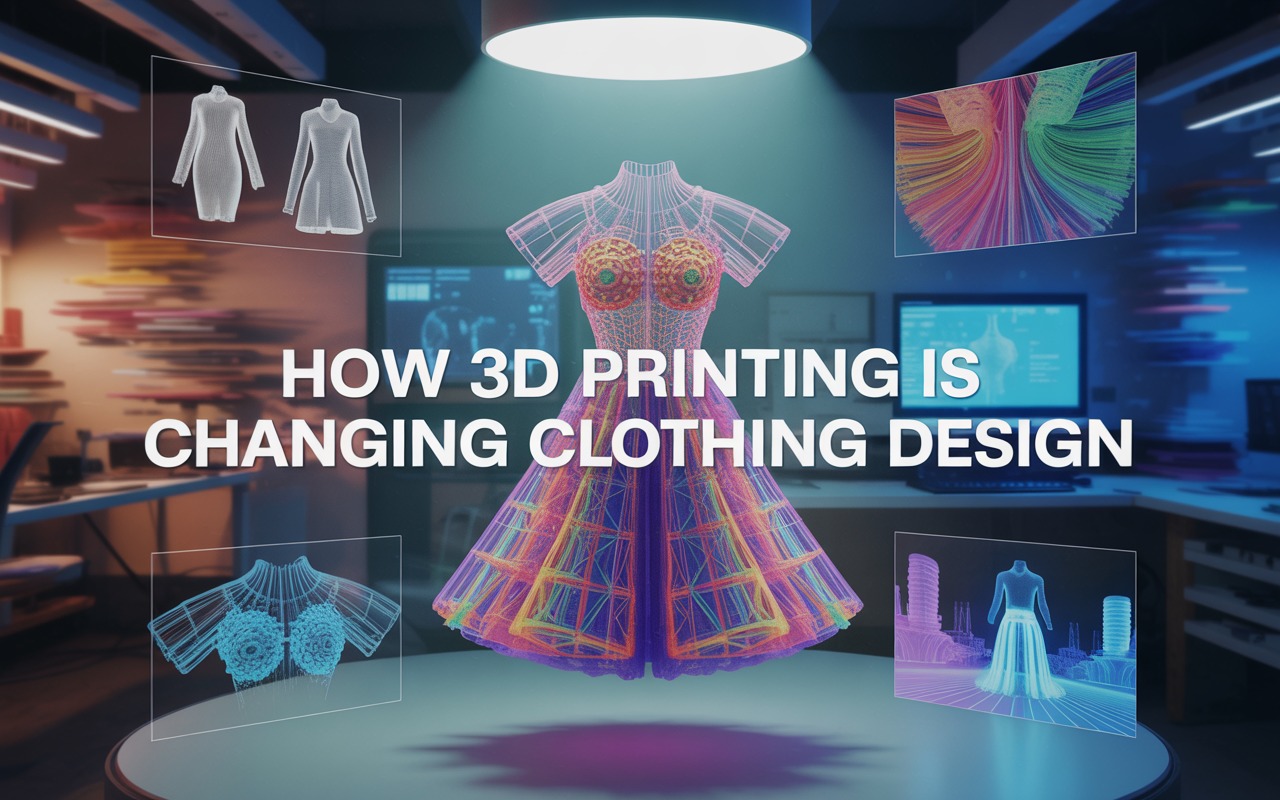3D printing, also known as additive manufacturing, has transformed industries from aerospace to healthcare, but its impact on clothing design is particularly revolutionary. By enabling designers to create intricate, customized, and sustainable garments, 3D printing is redefining fashion’s creative and production paradigms. This 3,500-word article delves into the history, current applications, key concepts, benefits, challenges, and future trends of 3D printing in clothing design, offering valuable insights for enthusiasts and industry experts alike.
History of 3D Printing in Clothing Design
Early Beginnings
3D printing emerged in the 1980s with Charles Hull’s invention of stereolithography, but its application in fashion began in the early 2000s. Designers initially experimented with 3D-printed accessories due to material and technological limitations.
-
2000s: Iris van Herpen, a pioneer in 3D-printed fashion, debuted her first 3D-printed pieces in 2010, showcasing rigid, sculptural designs.
-
Material Constraints: Early 3D printers used hard plastics like ABS, unsuitable for wearable clothing but ideal for avant-garde accessories.
-
Technological Milestones: Fused Deposition Modeling (FDM) and Selective Laser Sintering (SLS) enabled more complex structures, laying the groundwork for wearable garments.
Mainstream Adoption
By the mid-2010s, advancements in flexible filaments and multi-material printing expanded possibilities, allowing designers to create functional clothing.
-
2013: Nike introduced 3D-printed cleat components, marking a shift toward performance wear.
-
2015: Designers like Danit Peleg showcased fully 3D-printed garments, such as her “Liberté” collection, printed using consumer-grade printers.
-
Cultural Impact: High-profile events like the Met Gala featured 3D-printed designs, increasing visibility and acceptance.
Current State of 3D Printing in Clothing Design
Technologies and Materials
Modern 3D printing technologies, such as Multi Jet Fusion (MJF) and Digital Light Processing (DLP), offer precision and versatility. Materials have evolved from rigid plastics to flexible, fabric-like polymers.
-
Key Technologies:
-
FDM: Affordable, widely used for prototyping and small-scale production.
-
SLS: Produces durable, intricate designs with fine details.
-
MJF: Enables high-volume production with consistent quality.
-
-
Materials:
-
Thermoplastic Polyurethane (TPU): Flexible, durable, and skin-friendly.
-
Nylon: Lightweight and strong, ideal for structural garments.
-
Bio-based Polymers: Emerging sustainable options like PLA derived from corn starch.
-
-
Hybrid Approaches: Combining 3D-printed elements with traditional textiles for enhanced wearability.
Applications in Fashion
3D printing is used across haute couture, sportswear, and everyday fashion, offering unprecedented design freedom.
-
Haute Couture:
-
Designers like Iris van Herpen create intricate, organic structures impossible with traditional methods.
-
Example: Her 2019 “Hypnosis” collection featured 3D-printed elements mimicking natural forms.
-
-
Sportswear:
-
Adidas and Under Armour use 3D printing for customized midsoles and performance-enhancing components.
-
Example: Adidas’s 4D Futurecraft shoe with lattice-structured soles.
-
-
Mass Customization:
-
Brands like Continuum Fashion offer bespoke designs tailored to individual body scans.
-
Example: Danit Peleg’s 3D-printed jackets, customizable via online platforms.
-
Industry Adoption
Major brands and startups are integrating 3D printing into their workflows, though adoption varies by market segment.
-
Luxury Brands: Embrace 3D printing for exclusive, high-cost pieces.
-
Athleisure: Focus on performance-driven applications like footwear.
-
Startups: Experiment with accessible, consumer-facing customization platforms.
Key Concepts in 3D-Printed Clothing Design
Digital Design and Modeling
3D-printed clothing begins with digital design software like Rhino, Blender, or CLO3D, allowing precise control over form and function.
-
Parametric Design: Algorithms generate complex geometries based on mathematical parameters.
-
Body Scanning: 3D scanners capture precise body measurements for tailored fits.
-
Software Integration: AI-driven tools optimize designs for printability and material efficiency.
Additive Manufacturing Process
Unlike subtractive manufacturing, 3D printing builds garments layer by layer, minimizing waste.
-
Layering: Material is deposited in thin layers, fused together to form the final piece.
-
Support Structures: Temporary scaffolds ensure stability during printing complex shapes.
-
Post-Processing: Sanding, dyeing, or coating enhances aesthetics and comfort.
Sustainability and Material Innovation
3D printing aligns with sustainable fashion by reducing waste and enabling eco-friendly materials.
-
Zero-Waste Design: Precise material use minimizes excess compared to traditional cutting.
-
Recyclable Materials: TPU and nylon can be recycled into new filaments.
-
Localized Production: On-demand printing reduces transportation emissions.
Benefits of 3D Printing in Clothing Design
Customization and Personalization
3D printing enables bespoke garments tailored to individual preferences and body types.
-
Fit Precision: Body scans ensure garments conform perfectly to the wearer.
-
Aesthetic Freedom: Customers can choose colors, patterns, and structural elements.
-
Accessibility: Platforms like Wiivv allow consumers to order custom-fit sandals online.
Sustainability
3D printing supports eco-conscious fashion by optimizing resource use.
-
Reduced Waste: Additive manufacturing uses only the material needed for the garment.
-
Sustainable Materials: Bio-based and recyclable filaments reduce environmental impact.
-
On-Demand Production: Eliminates overproduction and excess inventory.
Design Innovation
3D printing unlocks creative possibilities unattainable with traditional methods.
-
Complex Geometries: Organic, lattice-like structures enhance both aesthetics and functionality.
-
Rapid Prototyping: Designers can iterate quickly, testing concepts in hours.
-
Integration with Tech: Smart textiles with embedded sensors or conductive materials.
Table: Comparison of Traditional vs. 3D-Printed Clothing Production
|
Aspect |
Traditional Manufacturing |
3D Printing |
|---|---|---|
|
Material Waste |
High (cutting patterns generates scraps) |
Low (additive process uses only needed material) |
|
Customization |
Limited (mass production focus) |
High (bespoke designs via body scans) |
|
Production Speed |
Fast for mass production, slow for custom pieces |
Slower for single items, ideal for prototypes |
|
Design Complexity |
Limited by sewing and cutting techniques |
High (complex geometries possible) |
|
Sustainability |
High environmental footprint |
Lower footprint with recyclable materials |
Challenges of 3D Printing in Clothing Design
Technical Limitations
Current 3D printing technologies face hurdles in achieving the comfort and flexibility of traditional textiles.
-
Material Rigidity: Even flexible filaments like TPU lack the drape of cotton or silk.
-
Print Speed: Large garments can take hours or days to print, limiting scalability.
-
Printer Size: Most printers have small build volumes, restricting garment size.
Cost and Accessibility
High costs of equipment and materials hinder widespread adoption.
-
Printer Costs: Industrial 3D printers range from $50,000 to $500,000.
-
Material Expenses: Specialized filaments like TPU are pricier than traditional fabrics.
-
Skill Barrier: Designing for 3D printing requires expertise in CAD and additive manufacturing.
Consumer Acceptance
3D-printed clothing must overcome perceptions of being niche or experimental.
-
Comfort Concerns: Rigid or semi-flexible materials may feel unnatural to wear.
-
Aesthetic Bias: Consumers accustomed to traditional textiles may resist novel designs.
-
Cultural Shift: Educating consumers on the benefits of 3D-printed fashion takes time.
Regulatory and Ethical Issues
The fashion industry faces unique challenges in integrating 3D printing.
-
Intellectual Property: Digital designs are easily replicated, raising piracy concerns.
-
Labor Impact: Automation may reduce jobs in traditional garment manufacturing.
-
Material Safety: Ensuring 3D-printed materials are skin-safe and non-toxic.
Future Trends in 3D-Printed Clothing Design
Advancements in Materials
Ongoing research aims to develop softer, more breathable materials for 3D-printed clothing.
-
Smart Materials: Shape-memory polymers that adapt to body heat or movement.
-
Biofabrication: Lab-grown materials like mycelium or algae-based filaments.
-
Hybrid Textiles: Combining 3D-printed structures with natural fibers for better comfort.
Scalability and Mass Production
Improvements in printer speed and size will enable larger-scale production.
-
High-Speed Printers: Emerging technologies like Continuous Liquid Interface Production (CLIP) reduce print times.
-
Multi-Material Printing: Simultaneous use of rigid and flexible materials in one print.
-
Distributed Manufacturing: Local print hubs reduce shipping and logistics costs.
Integration with Technology
3D-printed clothing will increasingly incorporate wearable tech and smart features.
-
Embedded Electronics: Sensors for health monitoring or temperature regulation.
-
Augmented Reality (AR): AR apps for virtual try-ons before printing custom designs.
-
AI Optimization: Algorithms to enhance fit, reduce material use, and predict trends.
Circular Fashion Economy
3D printing supports a closed-loop system for sustainable fashion.
-
Recycling Systems: Grinding used 3D-printed garments into new filament.
-
Upcycling: Reprinting old designs into new styles without additional raw materials.
-
Decentralized Production: Consumers printing at home or local facilities.
Review
3D printing in clothing design is a game-changer, offering unparalleled customization, sustainability, and creative freedom. Pioneers like Iris van Herpen and brands like Adidas have demonstrated its potential, from avant-garde couture to performance wear. However, challenges like material limitations, high costs, and consumer skepticism persist. As technology advances, particularly in materials and scalability, 3D printing could democratize fashion, making bespoke designs accessible to all. Its alignment with sustainability goals positions it as a cornerstone of future fashion, though technical and cultural hurdles must be addressed to achieve mainstream adoption.
FAQs
What materials are used in 3D-printed clothing?
Common materials include TPU, nylon, and bio-based polymers like PLA, offering flexibility and durability.
How does 3D printing improve sustainability in fashion?
It reduces material waste, enables recyclable filaments, and supports on-demand production to minimize overstock.
Can 3D-printed clothing be as comfortable as traditional textiles?
While improving, 3D-printed materials often lack the softness and drape of fabrics like cotton, though hybrid designs help.
Is 3D-printed clothing affordable for consumers?
Currently, high costs limit accessibility, but advancements in technology may lower prices in the future.
What are the main challenges for 3D-printed fashion?
Key challenges include slow print speeds, material rigidity, high costs, and consumer acceptance.
Read More Also: What is Deadstock Fabric and Why It Matters
Conclusion
3D printing is reshaping clothing design by enabling customization, sustainability, and innovative aesthetics. From its experimental beginnings to its current applications in couture and sportswear, the technology offers transformative potential. Despite challenges like material limitations and high costs, ongoing advancements in materials, scalability, and integration with smart technologies promise a future where 3D-printed clothing is mainstream. As the fashion industry embraces this technology, it could lead to a more sustainable, personalized, and creative sartorial landscape, redefining how we design, produce, and wear clothing.




